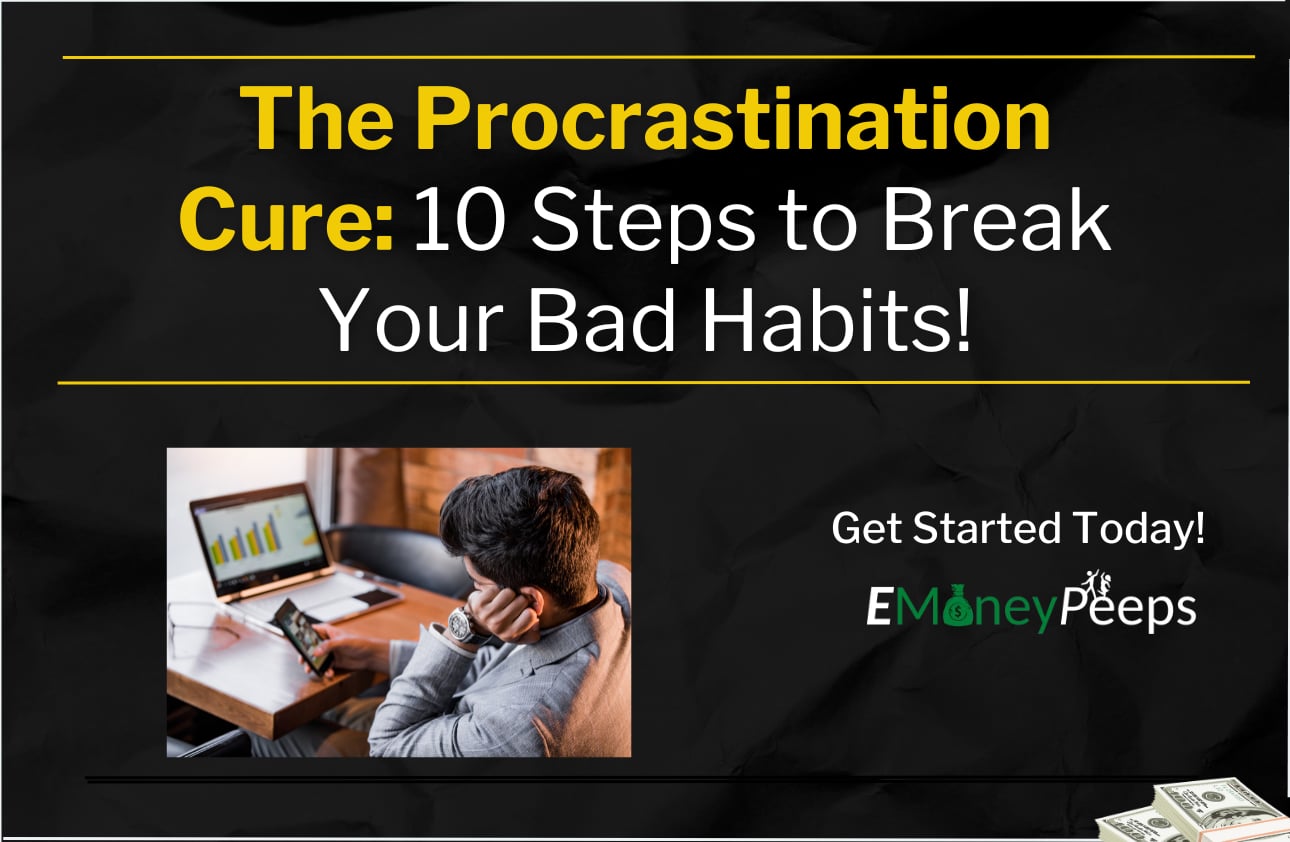The Procrastination Cure: 10 Steps to Break Your Bad Habits!

Before we get deep into procrastination and the steps you can take to break your bad habits – let’s see if you can relate to this little example.
It’s 5 p.m., and you suddenly realize the presentation you’ve been putting off needs to be done for tomorrows big meeting.
Your heart races and you start to get anxiety as the deadline looms.
You know you have to buckle down, open your laptop, spreadsheets, and get started. But instead, you find yourself reaching for your phone and watching videos on YouTube.
You had all week to get the presentation done, but just like every week you procrastinate until the last minute, and then wonder why you never get that promotion.
Maybe it’s not your job, maybe it’s your business, school work or jobs around the house that need to be done.
Procrastination Consequences
Procrastination almost always leads to negative consequences – Your spouse nags you, your boss gets on your case, you fail your class, your engine on your car seizes up because you never changed the oil when you were supposed to.
Your friends, family and co-workers don’t believe in you..There is no one standing in your corner when you attempt something new.
Because every-time you go to start a task in your life, you almost never finish it.
Sound familiar?
You’re not alone. This is the vicious cycle of procrastination—one most people have experienced at some point.
We can only stick our head in the sand so many times before the consequences will bite us in the ass!
But why do we keep procrastinating even though we know it’s bad for us?
Don’t Let Your Past Dictate Your Future: 10 Powerful Ways to Thrive

You’re Not A Procrastinator
First, let’s clear up a common misconception.
You’re not a procrastinator. You simply have bad habits of putting stuff off. And that’s a big difference and good news for you, because habits can be changed.
Here’s the thing about habits—they all follow a predictable pattern: a trigger, a behavior, and a reward.

Procrastination Habits Are Formed By Stress
In the case of procrastination, the trigger is always a stressor of some kind. We attach a negative emotion of some kind to the task at hand.
And what do we do as people? We try and avoid things that give us pain, such as negative emotions and stress.
Whether it’s the looming deadline, fear of failure, or feeling overwhelmed, stress is what kicks it off. Then, you engage in a pattern—avoiding the task at hand.
Maybe you scroll through social media, watch TV, or reorganize your desk, anything to avoid the work or task you’re stressed about.
Finally, there’s a reward: stress relief. Temporarily, the pressure lifts because you’ve avoided the source of stress, even though deep down you know it’s still waiting for you.
But here’s the good news—you don’t need to eliminate the triggers. Stress is a part of life, and you’re not going to get rid of it.
What you can do is change the pattern of avoidance.
- You are what you do daily.
- You first form your habits; then your habits form you.
- It’s just as easy to form habits of success as it is to form habits of failure.

Why Some People Never Seem To Procrastinate
People who are more successful in life share a couple very powerful traits:
- They have learned to attach extremely positive emotions to the sense of accomplishment and negative emotions to the act of failing to complete a task, and the act of doing nothing.
- They understand that time is our most valuable resource, and they refuse to waste it. Instead, they optimize every moment, using time as a tool to propel themselves toward their goals.
Meaning they have learned how to fuel themselves to get stuff done!
Another defining characteristic of highly successful individuals is their ability to prioritize and focus. They recognize that time, once gone, cannot be recovered.
This understanding drives them to invest their energy in tasks that align with their objectives, avoiding distractions and detours that don’t serve their purpose.
Mastering time management is another key to their success. They set clear, achievable goals, break them down into smaller, actionable steps, and allocate their time strategically.
This methodical approach ensures they stay on track, with each day contributing to their larger ambitions.
Procrastination, the ultimate roadblock to productivity, is something they actively overcome. Successful people know that putting things off only stalls progress.
Rather than giving in to procrastination, they take initiative, addressing challenges immediately and continuously pushing forward.
To put it all simply; successful people refuse to waste time, they NEED to be productive, and have a real sense of accomplishment, that’s what makes them feel good.
They associate negative emotions with things like watching TV, laying around, sitting to long, these things give them no reward.
“If you want something done, ask a busy person to do it. The more things you do, the more you can do.” – Lucille Ball

10 Steps to Break Your Bad Habits
Procrastination has a way of sneaking into many of our lives, making everything seem harder than it really is, or needs to be.
So let us help you break those bad procrastination habits once and for all. These aren’t just methods we’ve stumbled across—we have been using these strategies in our lives and business for many years.
1. Eat the Frog
Mark Twain once said, “If it’s your job to eat a frog, it’s best to do it first thing in the morning. And if it’s your job to eat two frogs, it’s best to eat the biggest one first.”
As strange as it sounds, this idea has been one of the best ways to deal with procrastination.
Imagine waking up every morning with the knowledge that you have to eat a slimy, croaking frog.
Naturally, if you didn’t eat it first thing in the morning, you’d dread the idea all day long, making your entire day miserable.
If you push it off until next week, guess what? You now have seven frogs to eat.
This is exactly what happens when you avoid what YOU THINK are unpleasant tasks—they pile up, making your situation worse.
So why not “eat the frog” first thing?
Doing the hardest, most dreaded task early in the day frees you up mentally and emotionally for the rest of the day.
You won’t spend your time haunted by the tasks you’re avoiding. Instead, you can enjoy a sense of relief, knowing the worst is already behind you.
2. The 3-2-1 Rule
The 3-2-1 rule sounds almost too simple to be effective, but sometimes simplicity is the key.
Here’s how it works: when you’re avoiding a task, say, writing an essay, you hold this thing that you have to do in your head and you reflect on it for a minute.
And you say, “I’ve got to go and do this thing.” Then simply count down in your head—“3, 2, 1”—and then go do the thing you were avoiding immediately.
The psychology behind this is powerful. Counting down is easy, and while counting, you’re preparing yourself mentally to act.
The countdown breaks the mental barrier between inaction and action. Once you start counting, you build momentum, and before you know it, you’re doing what you were dreading.
It sounds ridiculous, but give it a try. You’d be surprised how often this little trick works when you’re stuck in procrastination mode.

3. The Do-Something Principle
Mark Manson coined the “Do-Something Principle,” which flips the conventional wisdom about motivation.
Most of us think we need motivation to take action, but Manson argues that action creates motivation, not the other way around.
Think about it—how often have you felt unmotivated but still forced yourself to do something small?
Once you start, momentum builds, and before long, you’re fully engaged.
Starting is the hard part, but once you’re moving, the action itself fuels your motivation. The next time you feel uninspired, don’t wait for motivation to strike.
Do something, anything, even if it’s small. That tiny action can spark the momentum needed to tackle bigger tasks.
If The Plan Doesn’t Work, Change The Plan, Not The Goal
4. Purge Your Physical Surroundings
Ever notice how hard it is to focus in a cluttered, chaotic environment? There’s a reason for that.
The physical space around you has a direct impact on your mental state. If your workspace or home are a disaster, your brain will feel scattered too.
By cleaning and organizing your surroundings, you reduce distractions and create a space conducive to productivity.
This doesn’t mean you need a spotless room, but removing physical clutter can have a surprisingly profound effect on your ability to focus.
Think about it like this; imagine you need to mow the lawn, but your lawn mower is buried in your garage, and it will take you 20 minutes just to dig it out.
Your going to dread digging out to lawn mower because it is associated with negative emotions right off the bat.
So if you first clean out your garage and make it easy for you to get your lawn mower, the next time you need to mow your lawn might not seem like such a chaotic event.
Make sense?
5. Purge Your Digital Surroundings
In today’s hyper-connected world, your digital environment is just as important as your physical one.
Your phone buzzes, emails pop up, notifications flood your screen—every ding or ping pulls you away from what you’re doing.
To minimize distractions, clean up your digital space. Turn off non-essential notifications, close unused tabs, and create a digital environment that encourages focus rather than distraction.
When Mark Zuckerberg’s algorithms are fighting for your attention, it’s important to take control of what you allow into your mental space.
Are you running your life, or is it being run by constant digital interruptions and distractions?
Ever waste a few hours of a day endlessly scrolling through Facebook and YouTube reels?
6. Focus on One Thing for 60 Seconds
Here’s a tip I picked up from neuroscientist Andrew Huberman. If you’re feeling scattered or unfocused, try staring at a single point for 60 seconds while breathing deeply.
Focus your attention on one specific object or word at the same distance where you’d be doing your work.
This might sound silly, but this exercise aligns your mental and physical focus. Our brains and eyes are closely linked, and when we engage our visual focus, our mental focus tends to follow.
Try it the next time your thoughts are all over the place—it’s a quick way to collect yourself and dive into work.

7. Confront Your Distractions (Intentionally)
This strategy might seem counterintuitive, but it’s been a game-changer for us. Rather than trying to suppress distractions, set a timer for 10 or 15 minutes and fully engage with them.
Check your messages, scroll through Instagram—do whatever it is that’s pulling at your attention. But do it intentionally.
By allowing yourself this focused distraction time, you can mentally check it off and get it out of your system.
Once the timer goes off, you’ll find it easier to return to your task without the constant pull of distractions. It’s like making a deal with your brain—“I’ll let you have this distraction time, but after that, it’s time to focus.”
8. Make Lists
This does not always work for everyone, but for me and my wife it works profoundly well.
Every time I feel overwhelmed with the number of things I need to get done, I write them down into list.
And I break them down by the amount of time on average it will take me to do each task, whether for our home or for my online business.
Doing this seems to free up the negative feelings of being overwhelmed.
I then tackle the task that takes the least amount of time first, and pretty soon before you know it, I feel a real sense of accomplishment, and all of the task are done.
My wife is a little different in that she has learned to operate everyday off of her list, she writes everything down.
Otherwise, her brain is all over the map and she will not complete any task, because she will start one and then go to another because it pops into her brain.
So for years now she keeps a calendar with list in it, all planned out. She is very proficient and getting everything done.
Whatever Your Mind Can Conceive And Believe, You Can Achieve
9. Reward Yourself
Set a reward for yourself, but only after you’ve accomplished the task at hand.
However, don’t make the reward something passive like binging a Netflix series or scrolling through social media.
Instead, choose a fun, active reward that gets you moving—whether it’s going for a walk, playing a sport, or dancing to your favorite music.
This helps keep your momentum up and prevents you from slipping back into inactivity after completing your work.

10. Forgive Yourself
Stop dwelling on past mistakes. Thoughts like “I should have started earlier” or “I always procrastinate; I’m such a failure” only worsen the situation.
Research shows that forgiving yourself for past procrastination helps you break the cycle.
You can even turn past procrastination into a learning tool. Reflect on why you avoided the task in the first place—was it due to fear, stress, confusion, or a lack of accountability? Identify these obstacles and address them moving forward.
For instance, if fear held you back, what can you do next time to feel more confident and in control?
By understanding and confronting these barriers, you can prevent them from derailing your progress in the future
5 Minutes
Procrastination can feel like an unstoppable force, but it’s often just a set of habits that can be broken with the right strategies.
Whether it’s “eating the frog,” counting down from 3-2-1, or purging your environment, these tips are designed to get you out of your head and into action.
If you get stuck, try committing to just five minutes of a task. Why five minutes?
Because your problem isn’t the task itself—it’s the habit of avoiding it. Once you start, 80% of the time, you’ll keep going.
It’s not about finishing the task in one go; it’s about breaking the habit loop of avoidance.
Try a few, see what works for you, and remember, sometimes the hardest part is just starting.
We really hope this article The Procrastination Cure: 10 Steps to Break Your Bad Habits has been extremely helpful to you.
If you have any questions, don’t hesitate to post them in the comments section below or just say hello.
Sincerely,
Your Friends And Partners
Richard And John Weberg

Copyright Notice: If this content is reproduced in full on any other website other than EmoneyPeeps.com, it is without our permission, and is copyright infringement. We own all rights to this article. Any attempts to infringe the website content will result in strict legal actions. You are free to link to any article on our website, but not copy our content.

